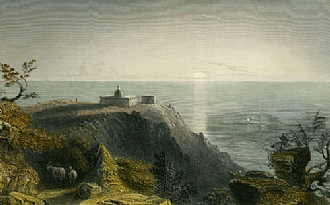
William Henry Bartlett, Mount Carmel Looking towards the Sea, engraving,
collection of Dr. Y. Rimon, Haifa
The Haifa City Museum in Israel is sponsoring a special exhibition entitled “Ottoman Haifa: Aspects of the City, 1516-1918” from August 29, 2009 – October 2, 2010. The curator is Ron Hillel. Details are provided at the exhibition website, with the description copied below.
During the Ottoman period, many marked changes occurred in Haifa and its environs. The foundations of today’s city were laid, economic, social, and religious. Even though Ottoman rule ended less than 100 years ago, the general sense is that all this happened in the remote past. This exhibition is intended to revive that heroic era, to make it tangible.
The exhibition follows Haifa’s development during the Ottoman period. The city’s growth is linked by indissoluble bonds to its technological and economic progress. Its development is documented in geographic illustrations and maps and with the invention of the camera in the 19th century it is also conveyed in photographic images and postcards.
In the 18th century, Daher-al-Omar-al-Zidani, a local governor, rose to power in northern Eretz Israel. He was a strong ruler with great military, political and economic power. He made Acre his capital, constructed its walls, and also annexed Haifa and its southern coastline. In 1760-61, after a failed attack by his enemies via the harbor, Daher decided to change Haifa’s location and improve its defences. To this end, his forces swiftly razed the ancient town and transferred it to a new site. Thus “New Haifa” was born – the nucleus of today’s city.
On the eve of WWI, after 400 years of Ottoman rule, Haifa had already become the foremost city of northern Israel, renowned and secure. In 1914, Haifa was still small – to foreign eyes a mere town. Nevertheless, there were few doubts about the future of such a lively and upcoming place. By the time the Ottomans left the country, Haifa already had the infrastructure for expansion that is still being implemented.
The exhibition is organized according to subject matter, in two interconnected sections. The first section presents Haifa as seen by visitors, an idealized vision in which imagination triumphs over reality. The second section deals with the economic aspects of Haifa’s development throughout the period. This section attempts to follow the contributory factors to creating Haifa’s current status – the transfer to a new site, founding the Christian community, the Templar settlement, development of the port and the railroad – elements that have formed the basis of today’s city.